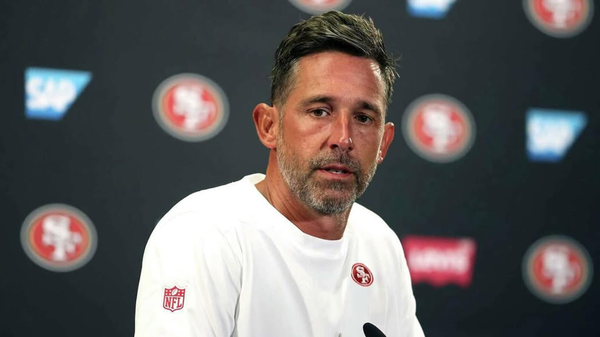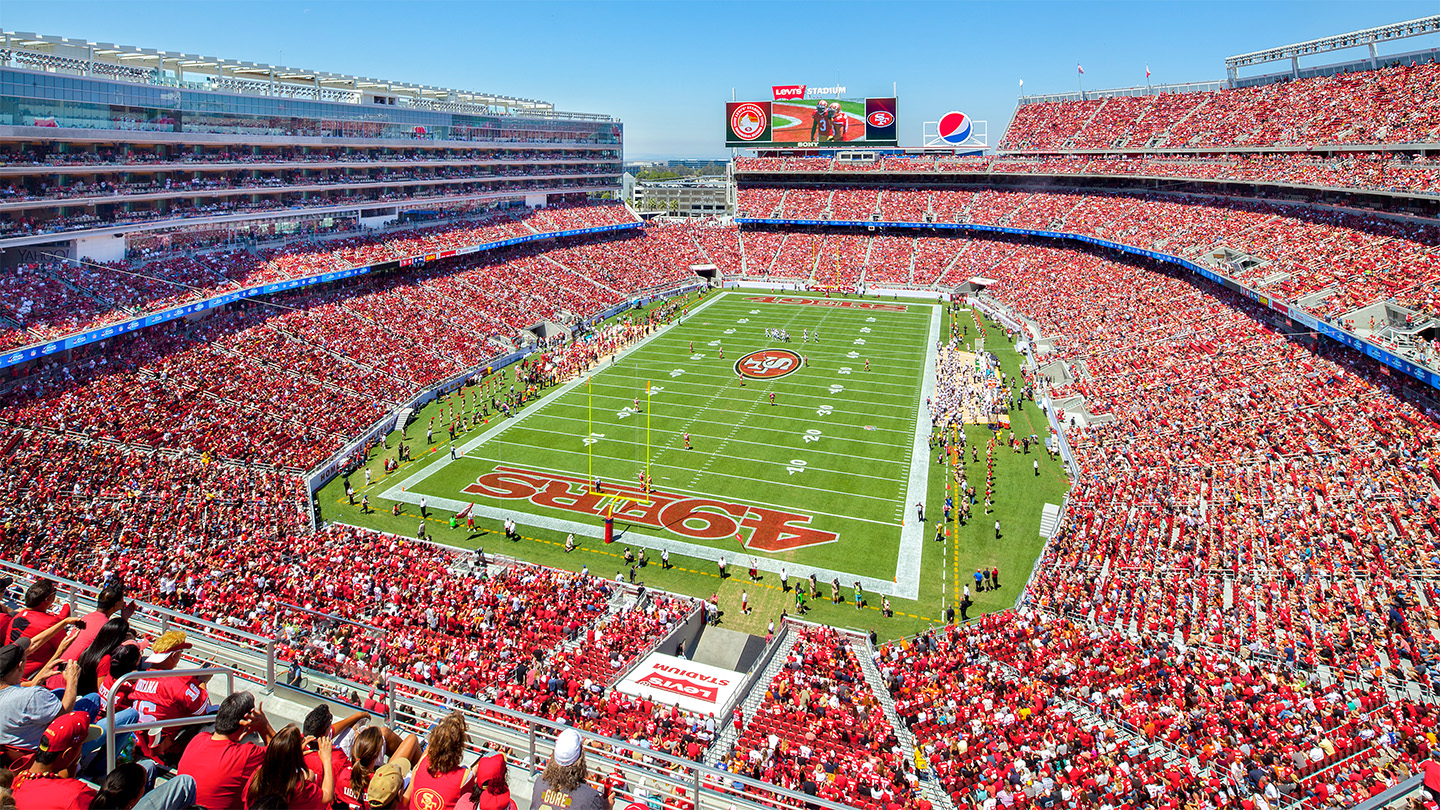

In the winter of ’82, as Joe Montana lofted that legendary spiral to Dwight Clark—later immortalized simply as “The Catch”—fans at Candlestick Park felt a shiver of destiny. They were convinced that something truly special was in the air. Fast-forward to 2025. That same feeling of electricity is tinged now with a foreboding that even the Faithful can’t shake. Levi’s Stadium, the pristine temple of Kyle Shanahan‘s 49ers glory, is on the brink of shouldering a financial burden. It’s so colossal that it could make Jed York flinch at the thought of opening his checkbook.
Watch What’s Trending Now!
The hint of that old gold-rush hunger, where every prospect felt like a risk, still lingers. But this time, the treasure at stake is measured not in rings but in tens of millions of dollars, and the question on everyone’s mind is, ‘Just how deep is the pocket, boss?’
“Given the pressure on the budget from Trump administration budget chaos, and the need to protect critical state programs,” Robert Salladay, Gov. Newsom’s senior communications adviser, explained in a terse email to the Chronicle, “the Governor did not include state funding for World Cup 2026 support in the May Revise proposal,” a move that effectively left the Bay Area Host Committee and, by extension, the 49ers scrambling to keep the lights on—and the games played.
ADVERTISEMENT
Article continues below this ad

ADVERTISEMENT
Article continues below this ad
But here’s where the plot thickens! Kyle Shanahan’s squad, already basking in the glow of two consecutive NFC Championship appearances (before struggling to a 6-11 last season) under his play-calling wizardry, suddenly finds itself abandoned by Sacramento, with the specter of covering six World Cup matches looming like a phantom sack on fourth down.
It starts with Santa Clara City Manager Jovan Grogan’s frank admission that staging World Cup games at Levi’s could sink as much as $50 million into the turf and the city’s coffers. Imagine the scene: Friday Night Lights are out, the roar of ‘Who’s got it better than us? Nobody!’ echoes in your head, and instead of celebrating a clutch TD, you’re wondering if the 49ers’ owner is going to start selling off his vintage game-worn helmets to make payroll.
With the stadium’s 68.5 k seating (expandable to about 75 k for big events), the economics of hosting a global tournament get messy fast: FIFA pays roughly $13 M for use of the publicly owned venue, but that’s pocket change compared to the operational costs—security, staffing, emergency services, and the kind of top-shelf production that’d make a Super Bowl blush.
It’s almost poetic how the 49ers, a franchise that once built dynasties on Mike Singletary’s defense and Jerry Rice’s route-running artistry, now find themselves offering to underwrite a nine-figure shortfall because ‘I am the one who knocks.’ Just as Walter White’s descent from chemistry teacher to kingpin was about taking control, Jed York’s implicit promise to pick up any tab left unpaid signals that the 49ers are ready to grab the reins—even if it means burning a half-century’s worth of franchise value in a single go.
Beneath the surface, the 49ers’ culture—an amalgam of West Coast innovation meets Midwestern grit—stretches to its limits. Back-room strategy sessions, once filled with charts analyzing Zach Ertz’s route-running or Nick Bosa’s pass-rush angles, now pivot to piecing together donor lists and lobbying schedules.
The Bay Area Host Committee, a nonprofit born of 49ers Enterprises, pledged to reimburse Santa Clara for every last dollar spent on game-day policing and medical teams. That’s why, when Grogan talked cost overruns of up to $50 M, it landed like a blitz package from Mick Tingelhoff: sudden, painful, and impossible to pick apart in time.
As the San Jose Earthquakes once reminded us when they first kicked off in this very facility back in August 2014, “This ain’t just football anymore,” and now those words echo louder than ever, because a soccer tournament is about to rewrite the rulebook on what it means to be a host.
Kyle Shanahan’s team abandoned by Sacramento
Then comes the real gut-punch: Gov. Gavin Newsom’s budget didn’t earmark a single dollar for 2026 World Cup support. For a state grappling with a $12 B deficit and juggling wildfires, homelessness, and seismic retrofits, the calculus is brutal but inevitable. In February, the Chronicle revealed that Newsom’s May Revise left the world’s biggest sporting event dangling, thrusting the Bay Area Host Committee—and by proxy, the 49ers—into a fiscal no-man’s land.
It forced a quiet scramble for private donations that so far haven’t materialized in the big-ticket way you’d expect from Silicon Valley’s free-spending titans. Sure, the committee snagged its first sponsor in May 2024, and they’ve added about a dozen donors since then. But they’ve yet to convince a multi-billion-dollar tech firm or a major energy player that buying into a World Cup makes sense when the ROI is locked under FIFA’s tight grip—and corporate perks like naming rights and ticket allocations are off the table.

The upshot? If those six matches at Levi’s fall short of breaking even, the 49ers have promised to cover a $37 M gap. Yeah, on top of whatever Santa Clara’s $50 M gets tagged at the end of the day. Measure J, the local charter clause barring city tax dollars from subsidizing stadium events, gave skeptical Council members Lisa Gilmore and Kelly Cox enough ammo to vote against the deal in February. They called for stronger guarantees to ensure taxpayers don’t end up footing the bill.
But when the vote passed 5–2, it became clear that the 49ers’ political heft, and the sheer scale of their deep-pocket backers, including Jed York and the Levi Strauss heir Daniel Lurie, tilted the tables in their favor. It’s a play straight out of Kyle Shanahan’s playbook. Dominate the line of scrimmage and force opponents into uncomfortable positions. However, except here, the opponent is a state budget. The stakes are measured in millions instead of yards.
For a franchise that once defined itself by golden-era legends like Bill Walsh and Joe Montana, this financial gambit feels almost Shakespearean. The 49ers, walking a tightrope between global spotlight and economic sinkhole. Fans will tell you that the Faithful have weathered worse. Three straight NFC Championship losses to the Chiefs, the pain of watching Terrell Owens dance on the goal line in 2003, or the heartbreak of a last-second field-goal defeat. However, nothing quite compares to the idea of Jed York’s empire bleeding out a half-century’s worth of fiscal clout just to host a few beautiful games of futbol.
ADVERTISEMENT
Article continues below this ad
And yet, as any true Niners diehard knows, this team has always been defined by its appetite for risk and its refusal to back down. Whether it’s carving up a defense with a perfectly timed zone-read or shouldering a massive World Cup shortfall, San Francisco is in the business of risking big. When the final whistle blows in July 2026, the real question will come. Whether the Faithful look back and celebrate another risk that paid off, or wince at the memory of a $50 million hole that Jed York had to dig himself out of?
ADVERTISEMENT
ADVERTISEMENT
ADVERTISEMENT
ADVERTISEMENT

